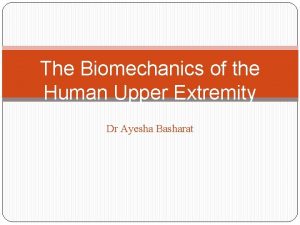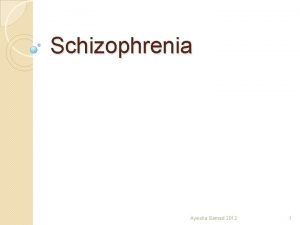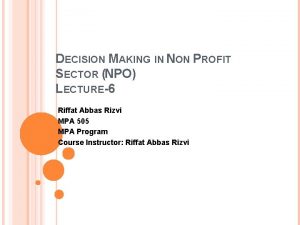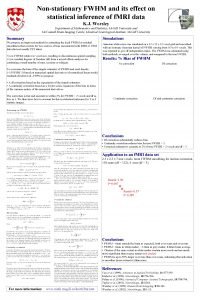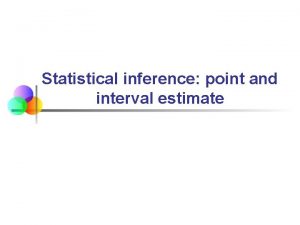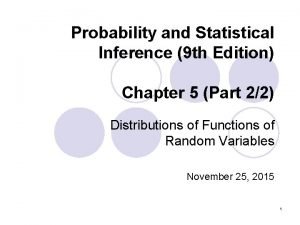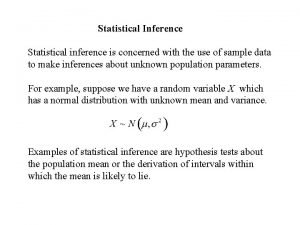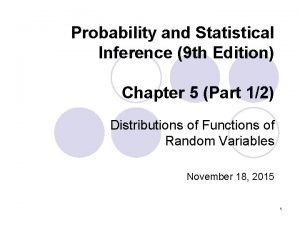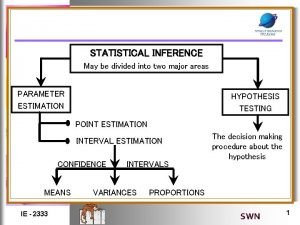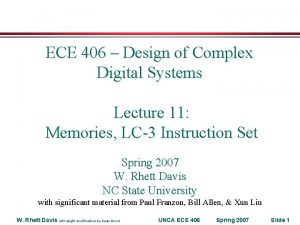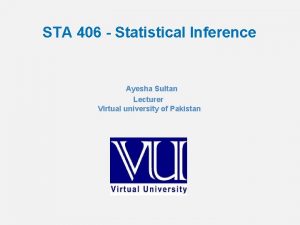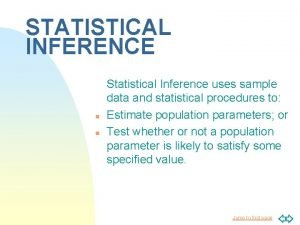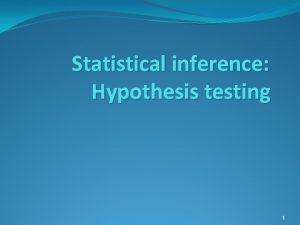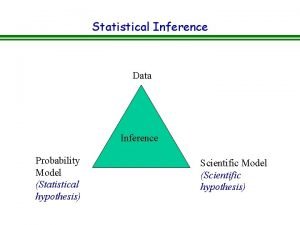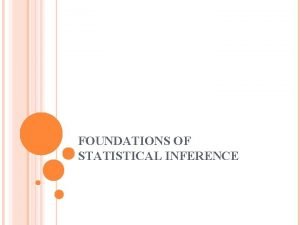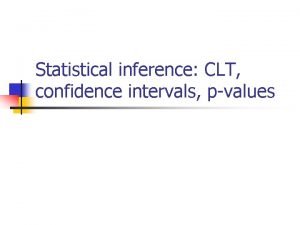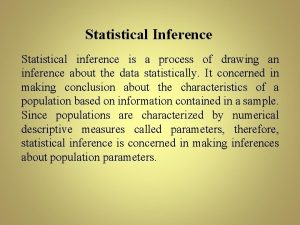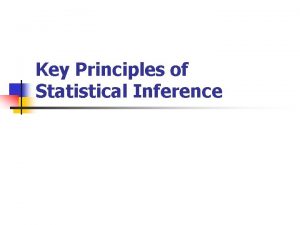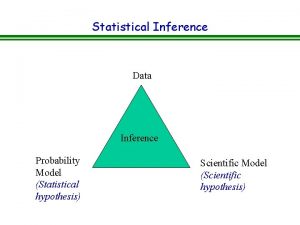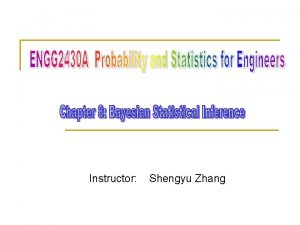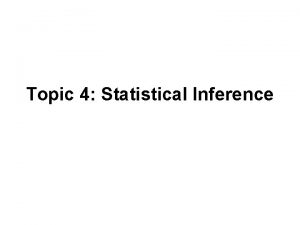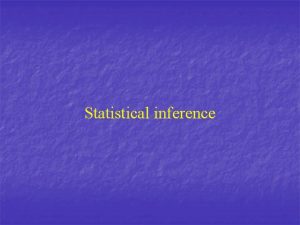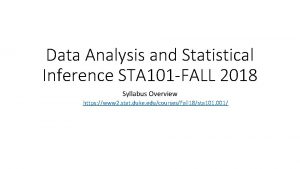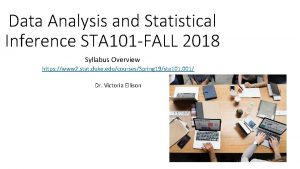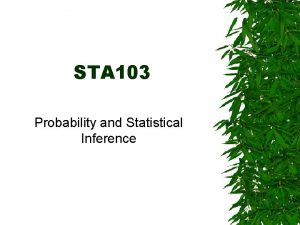STA 406 Statistical Inference Ayesha Sultan Lecturer Virtual



































- Slides: 35

STA 406 - Statistical Inference Ayesha Sultan Lecturer Virtual university of Pakistan

STA 406 - Statistical Inference Lecture No. 3

Confidence Interval Estimates • CONFIDENCE INTERVAL for For very small samples (n < 30) and is unknown. • where: • t = Critical value from tdistribution with n-1 degrees of freedom • = Sample mean • s = Sample standard deviation • n = Sample size

Fundamental principles for using the t -distribution for confidence intervals:

Degree of Freedom The degree of freedom for an estimate is equal to the number of values minus the number of parameters estimated en route to the estimate. For example, if there are two values (8 and 5) and we had to estimate one parameter (μ) on the way to estimating the parameter of interest (σ2). Therefore, the estimate of variance has 2 - 1 = 1 degree of freedom. Similarly, if there are 12 sampled observations then our estimate of variance would have had 11 degrees of freedom as the degrees of freedom of an estimate of variance is equal to n - 1, where n is the number of observations.

Question 1 : You know the population mean for a certain test score. You select 10 people from the population to estimate the standard deviation. How many degrees of freedom does your estimation of the standard deviation have?

Answer : There are 10 independent pieces of information, so there are 10 degrees of freedom.

Question 2: You do not know the population mean for a different test score. You select 15 people from the population and use this sample to estimate the mean and standard deviation. How many degrees of freedom does your estimation of the standard deviation have?

Answer: The degree of freedom for an estimate is equal to the number of values minus the number of parameters estimated en route to the estimate in question. You have 15 values in your sample, and you need to estimate one parameter, the mean, in order to find the standard deviation. 15 - 1 = 14.

t distributions • Very similar to Z~N(0, 1) • Sometimes called Student’s t distribution; Properties: i) symmetric around 0 (like z) ii) degrees of freedom

Student’s t Distribution Z -3 -3 -2 -2 -1 -1 00 11 22 33

Student’s t Distribution Z t -3 -3 -2 -2 -1 -1 00 11 22 33

Student’s t Distribution Degrees of Freedom Z t 1 -3 -3 -2 -2 -1 -1 00 11 22 33

Student’s t Distribution Degrees of Freedom Z t 1 t 7 -3 -3 -2 -2 -1 -1 00 11 22 33

dfp 1 2 3 4 5 0. 40 0. 324920 0. 288675 0. 276671 0. 270722 0. 267181 0. 25 1. 000000 0. 816497 0. 764892 0. 740697 0. 726687 0. 10 3. 077684 1. 885618 1. 637744 1. 533206 1. 475884 0. 05 6. 313752 2. 919986 2. 353363 2. 131847 2. 015048 0. 025 12. 70620 4. 30265 3. 18245 2. 77645 2. 57058 0. 01 31. 82052 6. 96456 4. 54070 3. 74695 3. 36493 0. 005 63. 65674 9. 92484 5. 84091 4. 60409 4. 03214 0. 0005 636. 6192 31. 5991 12. 9240 8. 6103 6. 8688 6 7 8 9 10 0. 264835 0. 263167 0. 261921 0. 260955 0. 260185 0. 717558 0. 711142 0. 706387 0. 702722 0. 699812 1. 439756 1. 414924 1. 396815 1. 383029 1. 372184 1. 943180 1. 894579 1. 859548 1. 833113 1. 812461 2. 44691 2. 36462 2. 30600 2. 26216 2. 22814 3. 14267 2. 99795 2. 89646 2. 82144 2. 76377 3. 70743 3. 49948 3. 35539 3. 24984 3. 16927 5. 9588 5. 4079 5. 0413 4. 7809 4. 5869 11 12 13 14 15 0. 259556 0. 259033 0. 258591 0. 258213 0. 257885 0. 697445 0. 695483 0. 693829 0. 692417 0. 691197 1. 363430 1. 356217 1. 350171 1. 345030 1. 340606 1. 795885 1. 782288 1. 770933 1. 761310 1. 753050 2. 20099 2. 17881 2. 16037 2. 14479 2. 13145 2. 71808 2. 68100 2. 65031 2. 62449 2. 60248 3. 10581 3. 05454 3. 01228 2. 97684 2. 94671 4. 4370 4. 3178 4. 2208 4. 1405 4. 0728 16 17 18 19 20 0. 257599 0. 257347 0. 257123 0. 256923 0. 256743 0. 690132 0. 689195 0. 688364 0. 687621 0. 686954 1. 336757 1. 333379 1. 330391 1. 327728 1. 325341 1. 745884 1. 739607 1. 734064 1. 729133 1. 724718 2. 11991 2. 10982 2. 10092 2. 09302 2. 08596 2. 58349 2. 56693 2. 55238 2. 53948 2. 52798 2. 92078 2. 89823 2. 87844 2. 86093 2. 84534 4. 0150 3. 9651 3. 9216 3. 8834 3. 8495 21 22 23 24 25 0. 256580 0. 256432 0. 256297 0. 256173 0. 256060 0. 686352 0. 685805 0. 685306 0. 684850 0. 684430 1. 323188 1. 321237 1. 319460 1. 317836 1. 316345 1. 720743 1. 717144 1. 713872 1. 710882 1. 708141 2. 07961 2. 07387 2. 06866 2. 06390 2. 05954 2. 51765 2. 50832 2. 49987 2. 49216 2. 48511 2. 83136 2. 81876 2. 80734 2. 79694 2. 78744 3. 8193 3. 7921 3. 7676 3. 7454 3. 7251

t-Table: text- inside back cover • 90% confidence interval; df = n-1 = 10 Degrees of Freedom 0. 80 1 3. 0777 2 1. 8856. . 10 1. 3722 0. 90 6. 314 2. 9200. . 1. 8125 0. 98 12. 706 4. 3027. . 2. 2281 31. 821 6. 9645. . 2. 7638 . . 100 1. 2901 1. 282 1. 6604 1. 6449 1. 9840 1. 9600 2. 3642 2. 3263 0. 99 63. 657 9. 9250. . 3. 1693. . 2. 6259 2. 5758

P(t > 1. 8125) =. 05 P(t < -1. 8125) =. 05. 90. 05 -1. 8125 0 . 05 1. 8125

Comparing t and z Critical Values z = 1. 645 z = 1. 96 z = 2. 33 z = 2. 58 Confidence level 90% 95% 98% 99% n = 30 t = 1. 6991 t = 2. 0452 t = 2. 4620 t = 2. 7564

Example An investor is trying to estimate the return on investment in companies that won quality awards last year. A random sample of 25 such companies is selected, and the return on investment is recorded for each company. The data for the 25 companies have Construct a 95% confidence interval for the mean return.


Example Cardiac deaths increase after heavy snowfalls, a study was conducted to measure the cardiac deaths of shoveling snow by hand. The maximum heart rates for 10 adult males were recorded while shoveling snow. The sample mean and sample standard deviation were 175 and 15 respectively. Find a 90% CI for the population mean maximum heart rate for those who shovel snow.

Solution

Example The masses, in grams, of twelve ball bearings taken at random from a batch are 31. 4, 33. 1, 35. 9, 34. 7, 33. 4, 34. 5, 35. 0, 32. 5, 36. 9, 36. 4, 35. 8 and 33. 2. Calculate a 90% confidence interval for the mean mass of the population, supposed normal, from which these masses were drawn.

Confidence Interval Estimates for 1 - 2 STANDARD DEVIATIONS UNKNOWN AND 12 = 22 where: = Pooled standard deviation t /2 = critical value from t-distribution for desired confidence level and degrees of freedom equal to n 1 + n 2 -2

Example

Confidence Interval Estimates for 1 - 2 STANDARD DEVIATIONS UNKNOWN AND 12 22 where: t /2 = critical value from t-distribution for desired confidence level and degrees of freedom equal to:

Confidence Interval Estimate for paired samples Paired samples are samples that selected such that each data value from one sample is related (or matched) with a corresponding data value from the second sample. The sample values from one population have the potential to influence the probability that values will be selected from the second population.

Confidence Interval Estimate for paired samples PAIRED CONFIDENCE INTERVAL ESTIMATE

Confidence Interval Estimate for paired samples PAIRED DIFFERENCE where: d = Paired difference x 1 and x 2 = Values from sample 1 and 2, respectively

Confidence Interval Estimate for paired samples MEAN PAIRED DIFFERENCE where: di = ith paired difference n = Number of paired differences

STANDARD DEVIATION FOR PAIRED DIFFERENCES where: di = ith paired difference = Mean paired difference

Example A nutrition scientist is assessing a weight-loss programme to evaluate its effectiveness. Ten people were randomly selected. Both the initial weight and the final weight after 20 weeks on the programme was recorded as: Subject Initial Weight Final Weight 1 180 165 2 142 138 3 126 128 4 138 136 5 170 6 205 197 7 116 115 8 142 128 9 157 144 10 136 130

Find the 95% confidence interval for the mean difference between Initial weight and Final weight. Assume that the mean differences are approximately normally distributed.

Example Twenty-two students were randomly selected from a population of 1000 students. All of the students were given a standardized English test and a standardized Math test. Find the 90% confidence interval for the mean difference between student scores on the Math and English tests. Assume that the mean differences are approximately normally distributed.

Test results are summarized below: Student English(x) 1 2 3 4 5 6 7 8 9 10 11 12 13 14 15 16 17 18 19 20 21 22 Math(Y) 95 89 76 92 91 53 67 88 75 85 90 85 87 85 85 68 81 84 71 46 75 80 90 85 73 90 90 53 68 90 78 89 95 83 83 83 82 65 79 83 60 47 77 83
 Lecturer's name
Lecturer's name Umer zeeshan ijaz
Umer zeeshan ijaz Dr ayesha batool
Dr ayesha batool Boutonniere and swan neck deformity
Boutonniere and swan neck deformity Ayesha hasan md
Ayesha hasan md Ayesha samad
Ayesha samad Dr ayesha anwar
Dr ayesha anwar Dr ayesha ghous pasha
Dr ayesha ghous pasha Statistical inference
Statistical inference Point estimation
Point estimation Probability and statistical inference 9th solution
Probability and statistical inference 9th solution Statistical inference is concerned with
Statistical inference is concerned with Probability and statistical inference 9th solution pdf
Probability and statistical inference 9th solution pdf Statistical inference is divided into
Statistical inference is divided into Sta su slotovi a sta portovi
Sta su slotovi a sta portovi Potomci su
Potomci su Sta je slovo a sta glas
Sta je slovo a sta glas Sta je kanjon a sta klisura
Sta je kanjon a sta klisura Sta je pravac a sta smer
Sta je pravac a sta smer Sta su skalarne a sta vektorske velicine
Sta su skalarne a sta vektorske velicine Designation lecturer
Designation lecturer Lecturer in charge
Lecturer in charge Pearson lecturer resources
Pearson lecturer resources Good afternoon my dear students
Good afternoon my dear students Designation of lecturer
Designation of lecturer Cfa lecturer handbook
Cfa lecturer handbook Photography lecturer
Photography lecturer Gcwak
Gcwak Spe distinguished lecturer
Spe distinguished lecturer Jeannie watkins
Jeannie watkins Lecturer asad ali
Lecturer asad ali Lecturer in charge
Lecturer in charge Lecturer name
Lecturer name Lector vs lecturer
Lector vs lecturer Spe distinguished lecturer
Spe distinguished lecturer Ece 406
Ece 406



